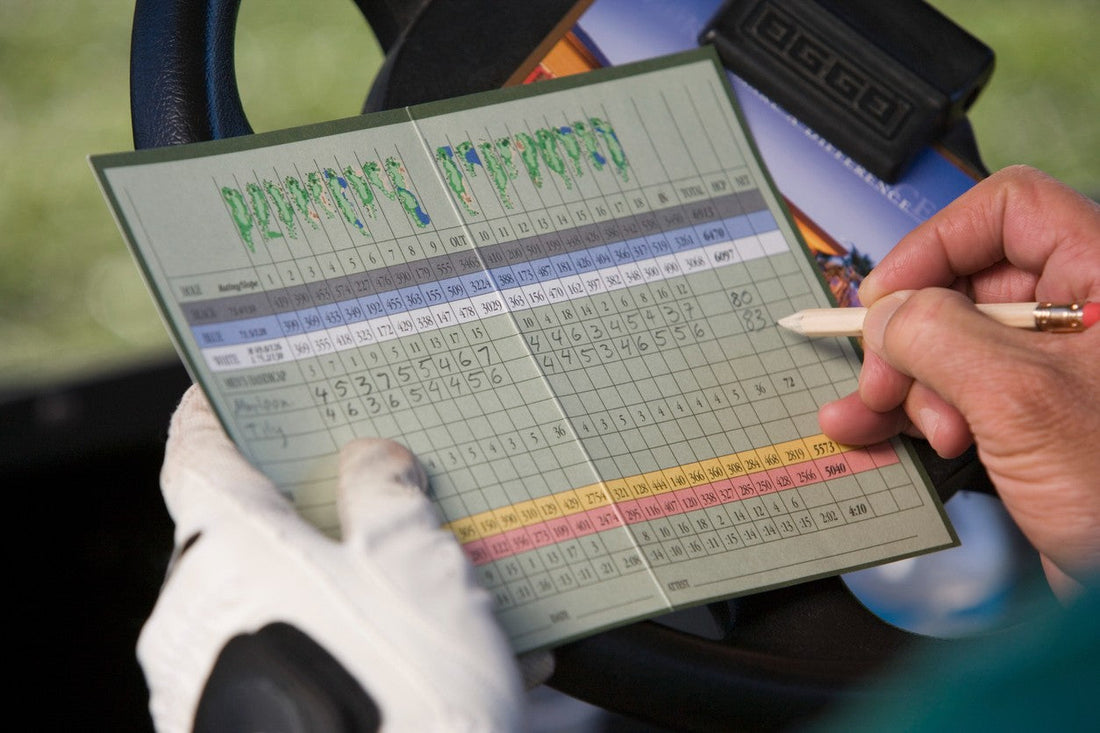UPDATED: 03/28/2025
Definition: A birdie is one stroke under par.
Golf is a game of contradictions: easy when you're playing well, tough when you're not, and constantly filled with terms that can leave you scratching your head. If you've ever heard a golfer bragging about a birdie, eagle, or albatross and thought, “What the heck are they talking about?”—you’re not alone!
Let’s break it down for you – golf's scoring terms, with a touch of humor to help it stick.
What is Par in Golf?
Before we dive into the fancy scoring terms, let’s start with the foundation: par. In golf, par refers to the number of strokes an expert player would take to get from tee to hole. Think of it as the standard for any given hole. It’s not as easy as it sounds, but par represents a “good” round for the pros.
In fact, par courses are typically rated at 72 strokes (for 18 holes), with par-3 holes requiring one stroke to the green, par-4 holes requiring two strokes, and par-5 holes requiring three.
We are here to help you learn the basics of golf scoring terms!
Read on to Learn:
- The 9 Top Golf Scoring Terms
- What Par Means
- Terms for Shots Under Par
- What an Ace Means in Golf
- What Playing Above Par Golf Means
What are the 9 Golf Scoring Terms to Know?

Before you learn the golf scoring terms, you need to know what a stroke is. A stroke (or strokes) might be one of the essential terms in golf scoring. Essentially, it represents how often a golfer swings (or putts) their club intending to strike the ball. If you attempt a swing and miss, it’s still counted as a stroke. All of the golf terms you are going to learn have to do with the number of strokes and par (which you will learn very soon).
Now, here are the main golf terms you need to know for your golf game:
-
The 9 Golf Scoring Terms You Need to Know:
-
Scratch or Par:
This is what a perfect golfer would shoot (according to golf course designers), but don’t worry, you don’t need to be Tiger Woods to have fun out there. -
Handicap:
This is a system that lets golfers of different skill levels compete more fairly. Think of it as a golf "adjustment" to level the playing field. -
Condor:
Okay, this one's rare. Scoring four under par on a hole is called a condor. Don’t expect to see one anytime soon unless you’re playing a par-6 hole and you’re feeling extra lucky. -
Albatross:
This one is a little less rare but still impressive: three strokes under par, usually on a par-5. We’re talking about legendary stuff here. -
Eagle:
An eagle is two strokes under par. You can often score this on a par-4 hole with a great drive and a chip-in. -
Birdie:
A birdie is one stroke under par. You’ve nailed it—now just avoid the eagle talk. (More on that later.) -
Bogey:
A bogey is one over par, like when you miss that birdie putt and find yourself wishing you had played better. -
Double Bogey:
Two over par. Think of it as your bad day on the course or the occasional misstep during an otherwise decent round. -
Triple Bogey:
Three over par. Yep, the dreaded snowman—often the result of an out-of-bounds shot or a bad bunker experience.
-
What Does Par Mean in Golf?

In the English lexicon, par means standard or average. In golf, par is a very different from the standard or average.
Golf courses are designed so an expert player can get from tee to hole in approximately 72 strokes (for 18 holes). On par-3 holes, it’s one stroke to the green, two putts. Par-4 holes, two strokes to the green, and two putts. And par-5 holes, three strokes to the green and two putts. Sound easy?
It's not for the average golfer. According to the United States Golf Association (USGA), a par golfer is “a player who can play to a Course Handicap of zero on any and all rated golf courses.”
And what does it take to shoot par? A whole lot of talent.
You may be asking, what is the Course Handicap or handicap system? The handicap system is employed at most courses and non-professional tournaments, and it means each player gets to deduct their handicap to make everything fair and fun.
If someone asks you, “Hey, what’s your handicap?” they don’t want to hear, “My arms are too short.” A golf handicap equals your score over at least a half-dozen rounds of play. You can ask at the pro shop, and they’ll explain how to enter your scores on your mobile, and you’ll be set.
Let's say you start with an 89, 92, 96, 91, 97, and 88. That makes your average golfer's score an 93.66, or 94. If the course is a par 72, the difference between your score and 72 gives you a handicap of 22. You’re doing fine.
No matter your score, your handicap, or your relativity to par score, we walk the course and enjoy the weather, the camaraderie, and the exercise a round of golf offers.
What Does it Mean to be Under Par in Golf?
If you’re under par, you’re enjoying something phenomenal – golf excellence. If the course is a par 71 and you shoot 68 (strokes), you are three under par. Congratulations! To get there, you're probably a seasoned golfer, and you’ve probably had several individual golf holes where you were under par. There are several different golf scoring terms for being under par, and each one is better than the last.
Birdie: The Holy Grail

It is important to know that a birdie is one under par. No one’s going to hand you a bird or anything, but that’s the term. Weird, huh?
According to golf history – and a plaque at the Atlantic City Country Club - Ab Smith is said to have coined the phrase in 1903 after making a shot that landed just six inches from the cup and exclaiming, “That was a bird of a shot.”
The shot was so pretty, he suggested, “When one of us plays a hole in one under par, he should receive double compensation.” Then, when the next time a player in the group shot one under par on a hole, they called it a birdie.
The term birdie flew (sorry) around the country club and across the globe. Birdies often happen after an excellent chip to the green leaves a short putt. Although, in recent news, Louis Oosthuizen dropped a 65-foot birdie putt at the Honda Classic 2022 in February. Wow!
Eagle: Two Under Par, Baby!
AB Smith also takes credit for the term eagle, which denotes two under par on a single hole. Eagles often happen on par 4 holes when a golfer chips in from near the green.
Think of it like this, outside of golf, an eagle is definitely bigger than a birdie. In a game of golf, an eagle is definitely better than a birdie.
Albatross
Let's take it a step further, under par that is. An albatross refers to three under par on an individual golf hole.
In golf majors (Masters, US Open, British Open, PGA Championship), only 18 players have ever made an albatross, including Louis Oosthuizen, who made the last one in the 2012 Masters. The previous player at the Masters with an albatross (or double eagle) was Jeff Maggert in 1994. The only player ever to record two elusive albatross scores is the same Jeff Maggert, who accomplished the previously impossible at the 2001 British Open.
Condor
Finally, if the albatross wasn’t big enough for you, there’s also the tiny possibility of scoring a condor. A condor is scoring four under par on a given hole. The first recorded condor was struck in 1962 by Larry Bruce. Also, in the group of 4-under par are Dick Hogan in 1973, Shaun Lynch in 1995, Mike Crean in 2002, and Jack Bartlett in 2007.
In 2020, Keven Pon, a professional golfer, made a list in fashion with a 2-stroke shot on the 667-yard 18th hole at Lake Chabot Golf Course in Oakland, California. Yup, an extremely rare feat and the only one known on an equally rare par-6 hole.
It takes consistent birdies or better to play under par, which is challenging even for expert golfers. When Australian golf professional Cameron Smith played in the 2020 Masters, he was the first player to play all four rounds with golf scores in the 60s – and he only tied for second.
What is an Ace (Hole-in-One)?
An ace, in non-golfer terms, is the holy grail of golf. It’s when you make a hole-in-one, sinking the ball in one shot. For some pros, it’s a regular occurrence, but for most golfers, it’s a lifelong dream.
Scoring Above Par: The Struggle is Real

And, for the not-so-perfect rounds, we’ve got terms like bogey, double bogey, and triple bogey. Don’t be discouraged; even the pros hit a few rough patches (just ask Jason Dufner). Besides, golf is as much about enjoying the day and the course as it is about scoring well.
In the scheme of things, playing above par means you are like most golfers. You are above par if the course is rated at 70 and you shoot 71 or higher.
A bogey is a one-over-par on a single hole, such as shooting a 5 on a par-4. Bogey golf is shooting one-over-par as an average for all holes. Bogey golf on a par 72 puts your score at about 90.
A double-bogey denotes two over par, perhaps a 5 on a par-3. The dreaded triple bogey is three over par, often an 8 (affectionately known as a snowman) on a par 5.
The Bottom Line: Golf is a Game of Learning
Whether you’re shooting a birdie or double bogey, the best part of golf is that there’s always room to improve. Take time to learn these terms, and they’ll help you stay on track as you work towards your own personal golf goals.
And remember, no matter your score, the key to enjoying your time on the course is using the right tools—like Cart Tek's electric golf push carts! Keep that energy up and enjoy every round!


